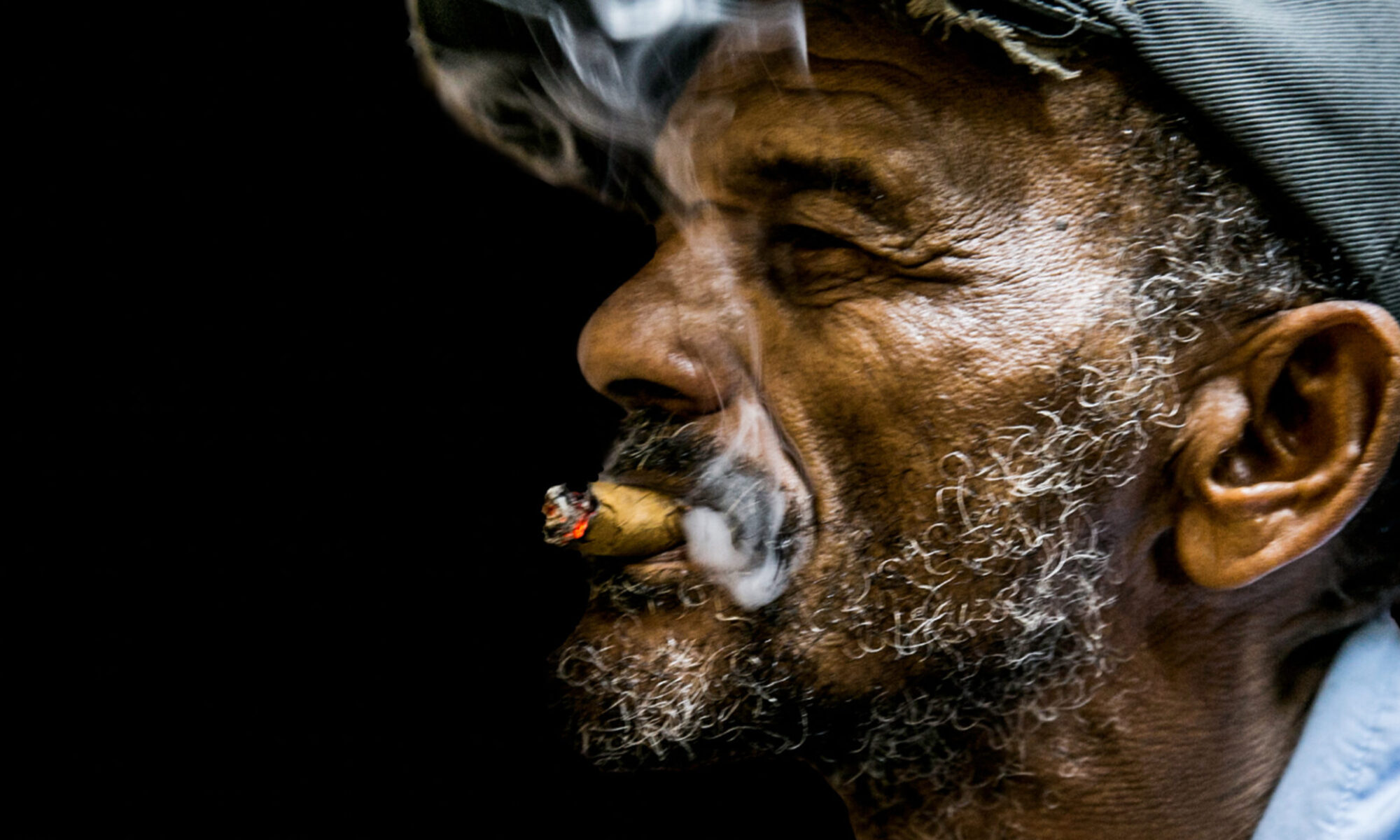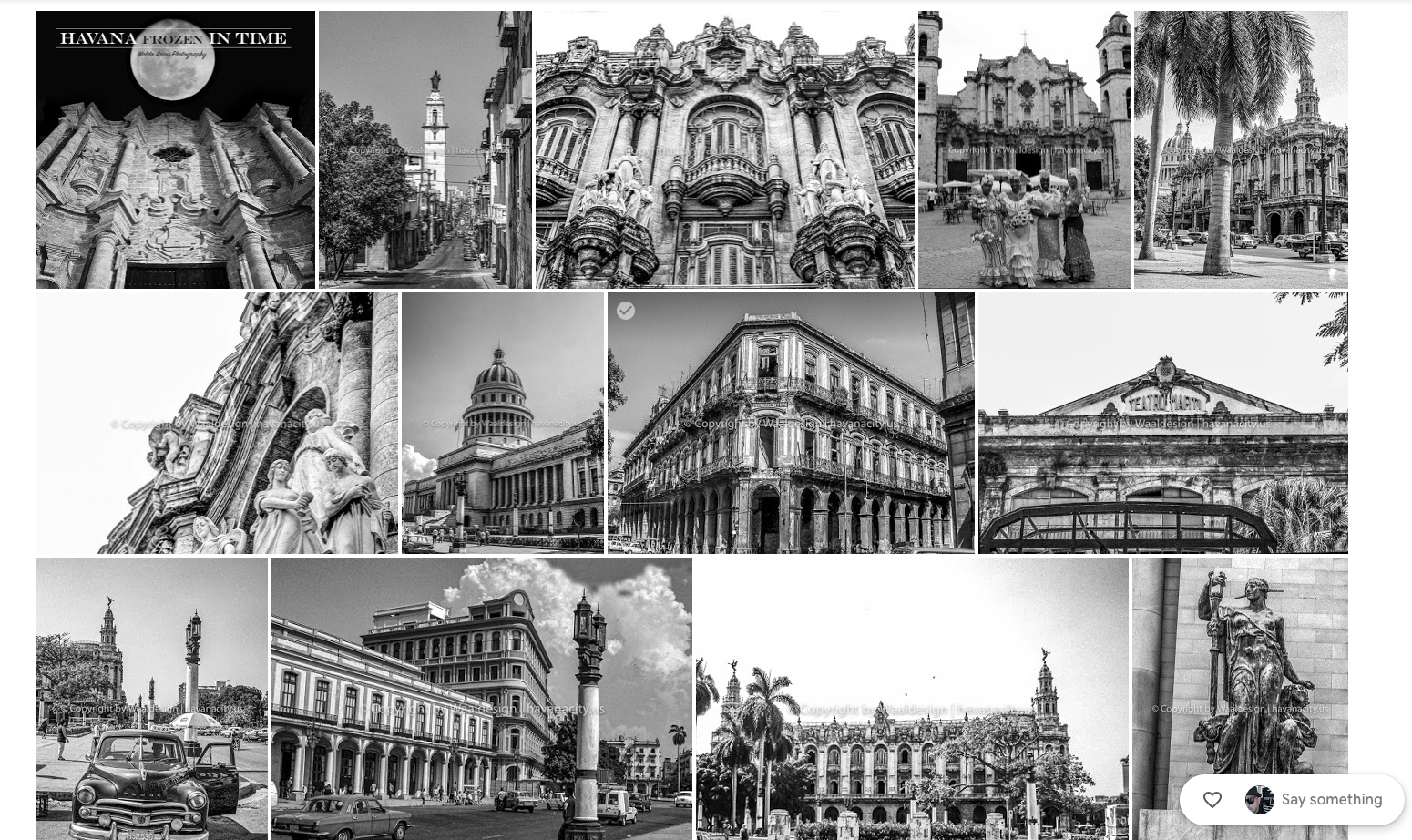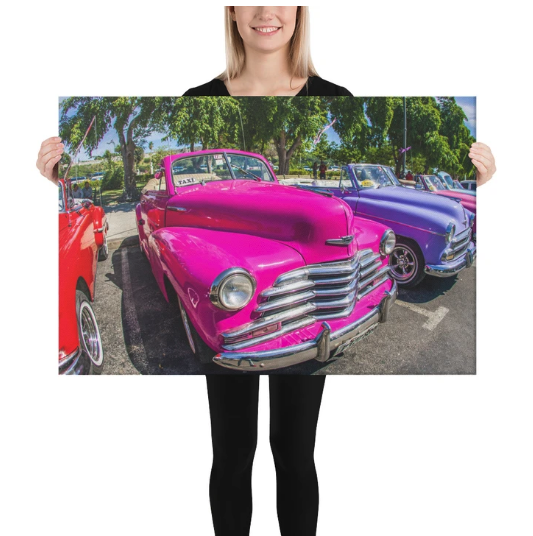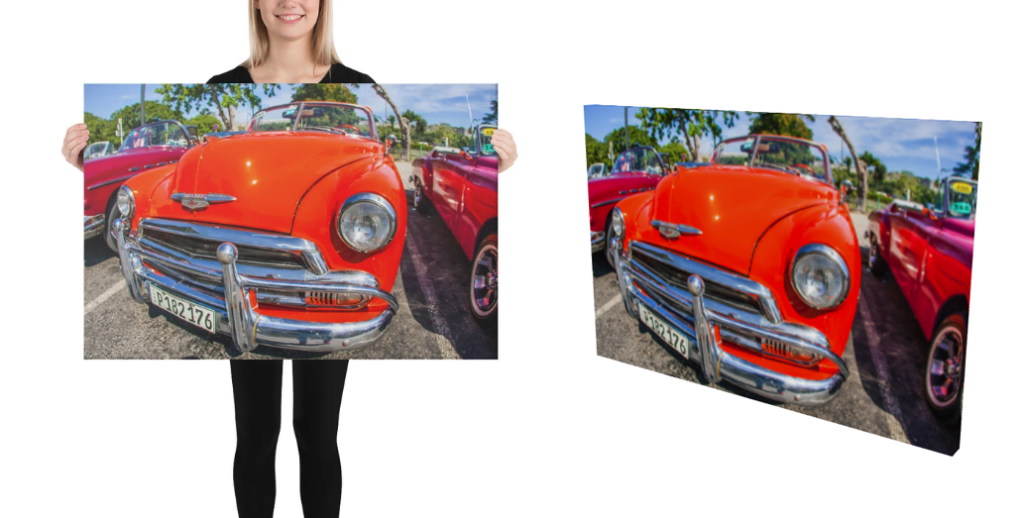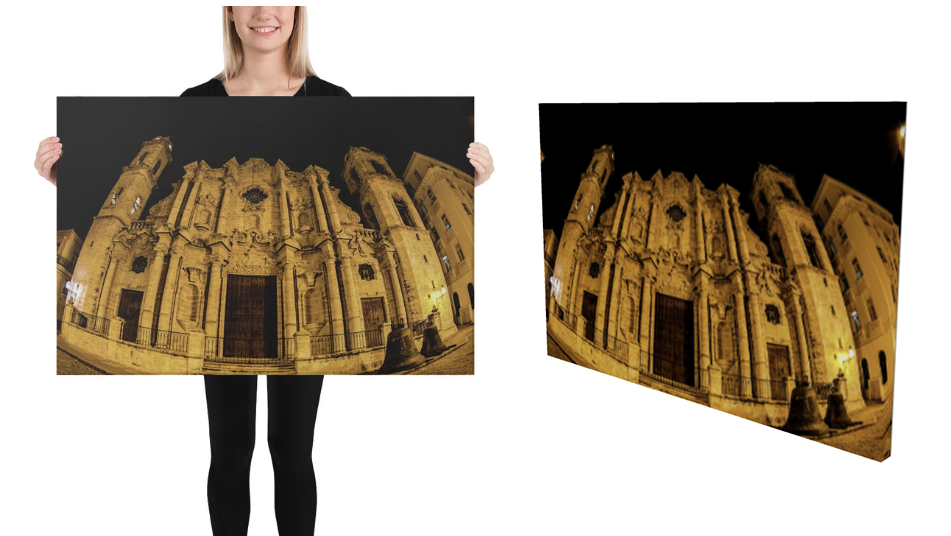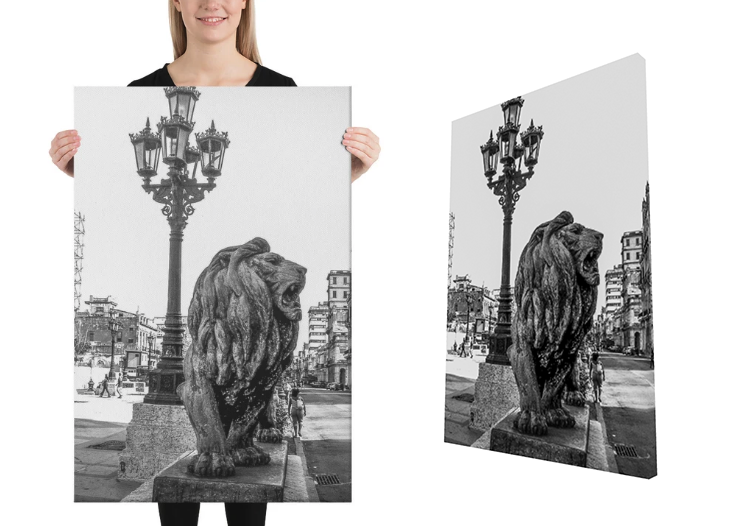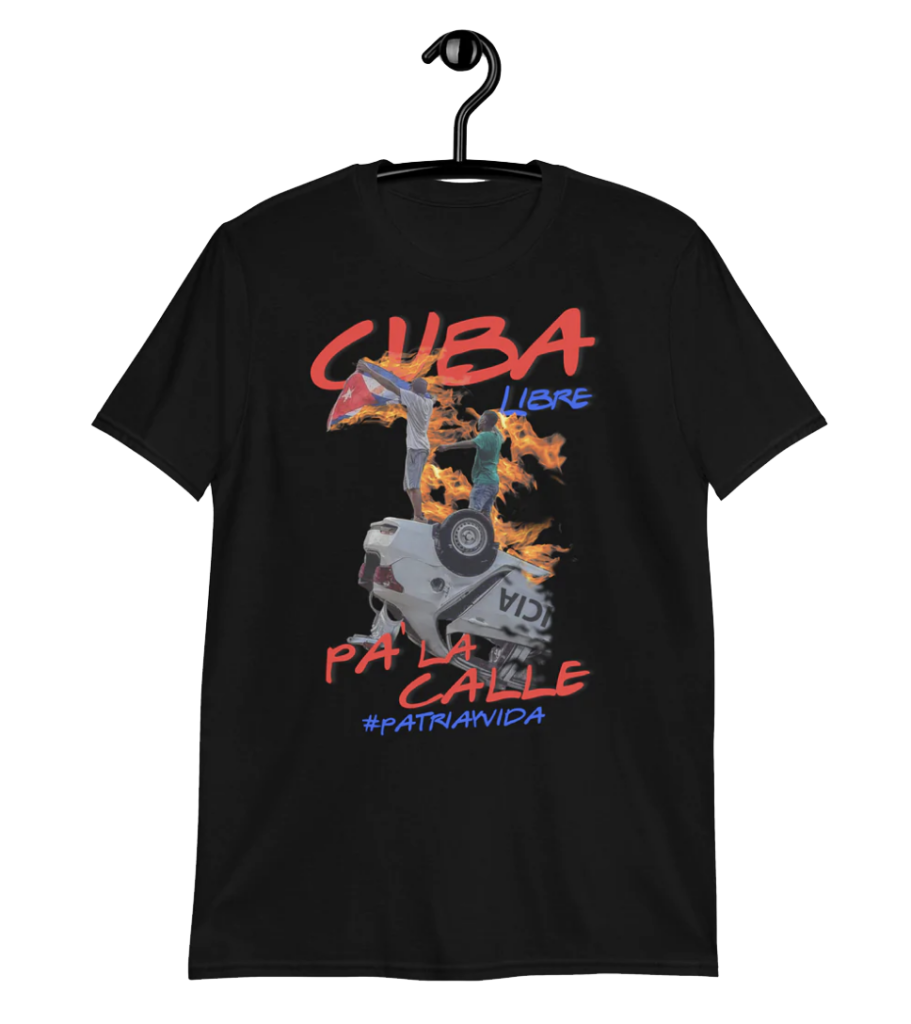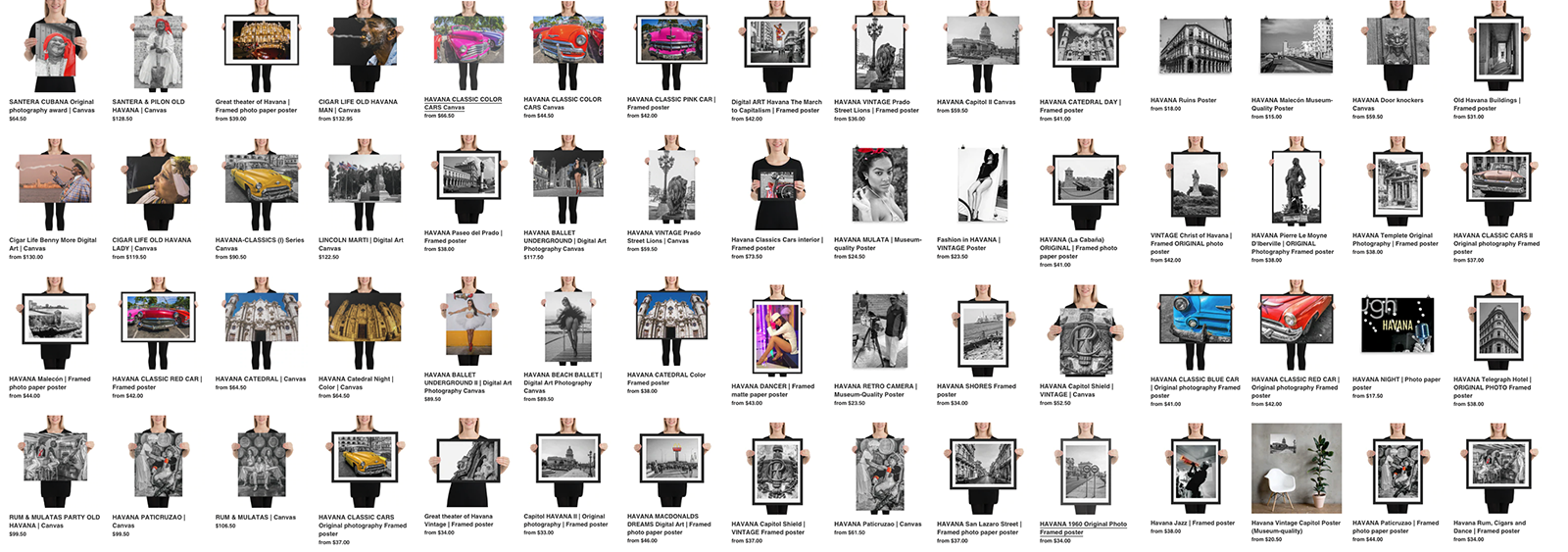HAVANA FROZEN IN TIME
Welcome to my Cuba Photo Exhibition, a visual journey through one of the world’s most captivating and unique countries. Through the lens of my cameras, I invite you to explore this fascinating island nation’s rich culture, history, and daily life.
From the bustling streets of Havana to the tranquil landscapes of the countryside, my collection of photographs captures the vibrant spirit and resilience of the Cuban people, as well as the stunning beauty of their country. Each image tells a story and offers a glimpse into a world frozen in time, where classic cars and colonial architecture coexist with modern-day innovations. We hope this exhibition will inspire you to discover more about Cuba, its people, and its fascinating history.
All the way to today and you will still have the sensation that you are in the 1950s. Many of these buildings, cars and people still exist against the corrosion of the Caribbean Sea. Havana and its people still keep moving. Even though almost everything is demolished it still has its magic. Cubans are inspired by the colors and beauty despite being in a devastated city. Here you can safely buy all kinds of merchandise in our associated store www.funtrendshirts.com.
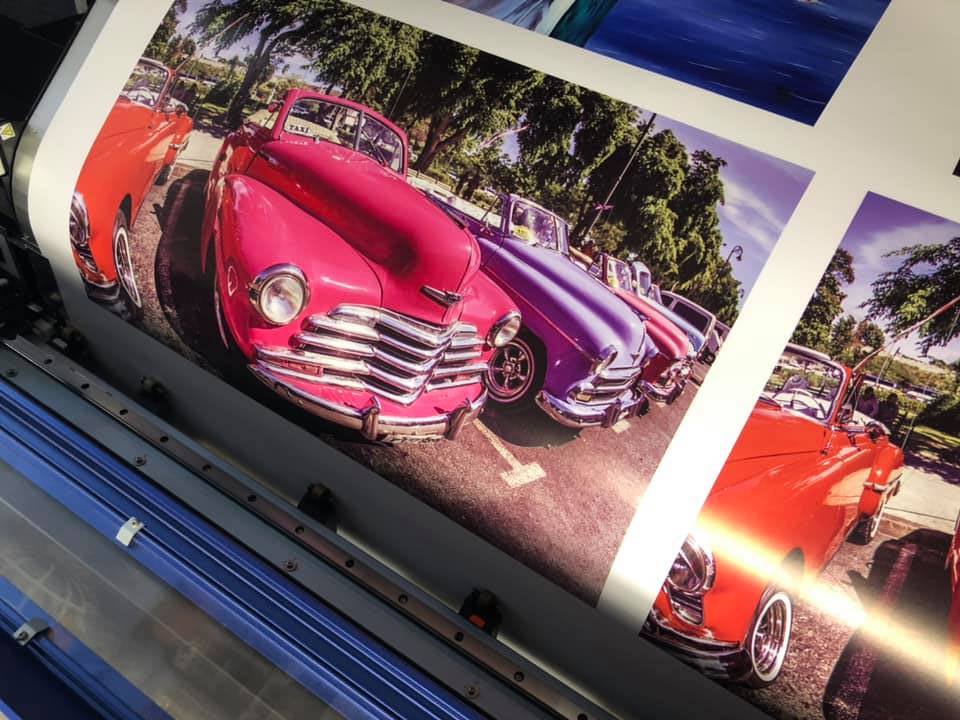
Take a look at some of our PRODUCTS. NOW you can decorate your office or home with original photos of the artist Waldo Arias from various exhibitions and competitions such as Art Basel, Art Takes New York and photo Expos around the world. This art photograph is a retelling of 50 years of Cuba turning away from the world. These Pictures have been taken in the 90s (some photographs taken with an SLR camera have the textured grain style). Others with DSLR.
OUR ONLINE STORES
GO TO OUR ONLINE STORE HAVANA CITY US is an information portal for generations of Cuban Americans and Cubans in all parts of the world to share images of Havana in its different stages. Here you can safely buy all kinds of merchandise in our associated store www.funtrendshirts.com. you can buy Cuban Memorabilia on our website or eBay (FUNTRENDINGSHIRTS)
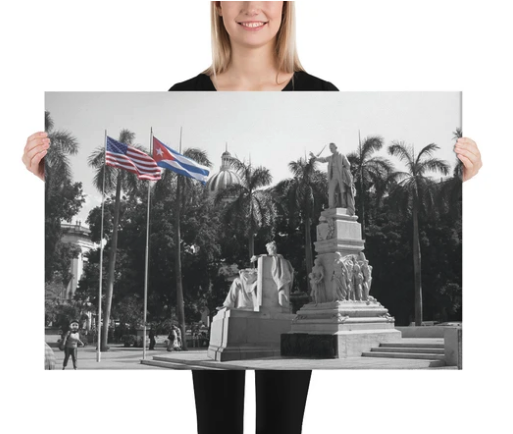
LINCOLN MARTI | Digital Art Canvas
Two personalities from different countries and cultures but with the same mission in life, to create a better nation where everyone is free.
Central Park, also known as Parque Central in Spanish, is a popular public park located in the heart of Havana, Cuba. The park is situated in the city’s historic district, surrounded by notable landmarks such as the Gran Teatro de La Habana, the Capitolio building, and the Inglaterra Hotel.
The park is a bustling hub of activity and a popular gathering place for locals and tourists alike. Visitors can stroll along the tree-lined paths, admire the colorful flower beds and sculptures, and relax on the benches while taking in the sights and sounds of the city.
Central Park is also a center of cultural activity in Havana, with frequent concerts, festivals, and other events taking place in the park’s open-air amphitheater. A park is an excellent place to experience the vibrant energy of Havana and to connect with the city’s rich cultural heritage.
Looking to add a little flair to your room or office? Look no further – this canvas print has a vivid, fade-resistant print that you’re bound to fall in love with.
• Acid-free, PH-neutral, poly-cotton base
• 20.5 mil (0.5 mm) thick poly-cotton blend canvas
• Canvas fabric weight: 13.9 oz/yd2(470 g/m²)
• Fade-resistant
• Hand-stretched over solid wood stretcher bars
• Matte finish coating
• 1.5″ (3.81 cm) deep
• Mounting brackets included.
Looking to add a little flair to your room or office? Look no further – this canvas print has a vivid, fade-resistant print that you’re bound to fall in love with this visual arts.
HAVANA CLASSIC COLOR CARS Canvas
Cars from the past that still roll in Havana to a Cuban survival model.
“Almendrones” is a term used in Cuba to refer to the classic American cars that are a common sight on the streets of Havana and other cities throughout the country. These cars date back to the 1950s and earlier, and their enduring popularity is a testament to the ingenuity and resourcefulness of the Cuban people.
Despite their age, “Almendrones” are often meticulously maintained and beautifully restored, with shiny chrome detailing and brightly painted exteriors that harken back to a bygone era. Many of these cars have been modified with modern engines and other parts to keep them running smoothly, while still retaining their original charm and character.
For locals, “Almendrones” are an essential part of daily life, serving as taxis, private vehicles, and even public transportation. For visitors to Cuba, these cars are a unique and memorable way to experience the country’s rich cultural heritage and history. Taking a ride in an “Almendron” is a must-do experience for anyone visiting Cuba, and is sure to leave a lasting impression.
HAVANA Catedral Night | Color | Canvas
The thirty by forty-nine meters rectangular church serves as the seat of the Roman Catholic Archdiocese of San Cristobal de la Habana. The Catedral de la Habana, also known as the Cathedral of Havana, is a stunning example of Baroque architecture. The cathedral’s ornate façade features two bell towers and intricate stone carvings that are sure to catch the eye of anyone passing by. Inside, visitors are treated to a peaceful and serene atmosphere, with beautiful stained glass windows casting colorful light across the nave. The cathedral’s central altarpiece, featuring an image of the Virgin Mary, is a must-see for any art lover. Built between 1748 and 1777, this iconic cathedral has been a cornerstone of Havana’s spiritual and cultural heritage for centuries.
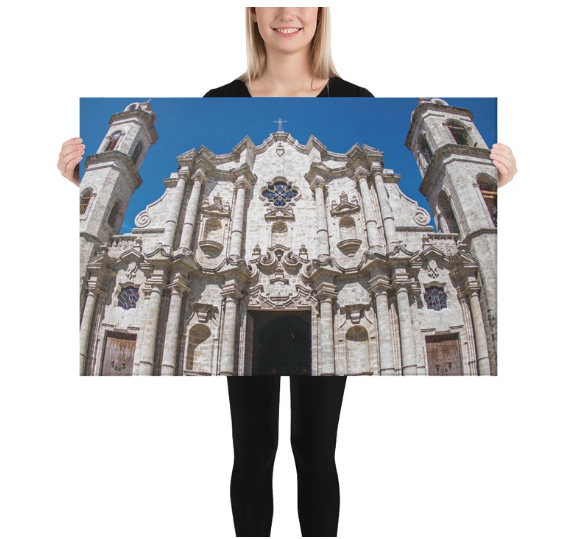
HAVANA CATEDRAL | Canvas
The Catedral de la Habana, also known as the Cathedral of Havana, is a stunning example of Baroque architecture. The cathedral’s ornate façade features two bell towers and intricate stone carvings that are sure to catch the eye of anyone passing by. Inside, visitors are treated to a peaceful and serene atmosphere, with beautiful stained glass windows casting colorful light across the nave. The cathedral’s central altarpiece, featuring an image of the Virgin Mary, is a must-see for any art lover. Built between 1748 and 1777, this iconic cathedral has been a cornerstone of Havana’s spiritual and cultural heritage for centuries.
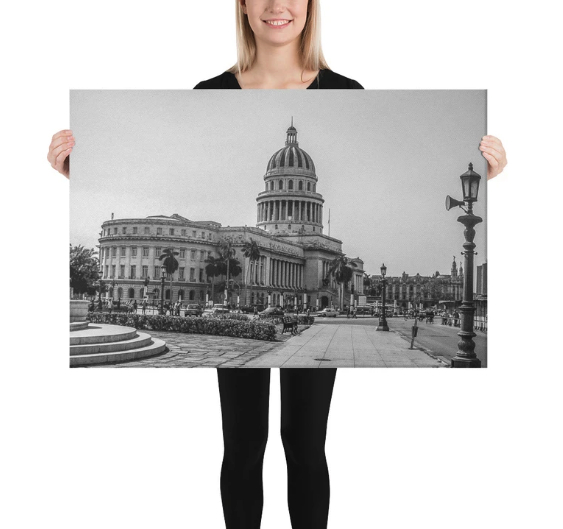
HAVANA Capitol II Canvas
The Capitolio de la Habana, or the National Capitol Building of Havana, is an iconic landmark located in the heart of Havana, Cuba. Completed in 1929, the building was designed by the architects Raúl Otero and Eugenio Rayneri Piedra in the neoclassical style and was modeled after the United States Capitol in Washington D.C.
The building’s most striking feature is its massive dome, which rises to a height of 92 meters (302 feet) and is visible from many parts of the city. Inside, the building houses the Cuban Academy of Sciences, as well as the National Library of Science and Technology.
The Capitolio was once home to the Cuban government, and many important historical events have taken place here, including the signing of the 1940 Cuban Constitution. Today, it serves as a popular tourist attraction, with visitors flocking to admire its grand architecture, stunning interiors, and historical significance.
In recent years, the building has undergone extensive renovations, with the goal of restoring it to its former glory. The project has included the restoration of the building’s exterior façade, the replacement of its original copper dome, and the refurbishment of many of its ornate interior features.
HAVANA VINTAGE Prado Street Lions | Canvas
Looking to add a little flair to your room or office? Look no further – this canvas print has a vivid, fade-resistant print that you’re bound to fall in love with.
VINTAGE Prado Street Lions. The photographs were taken with a SLR camera have the textured grain style.
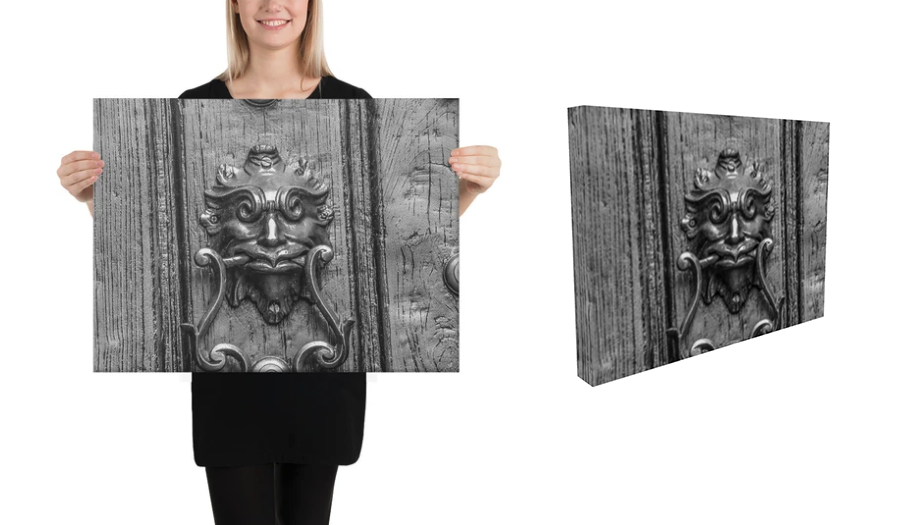
HAVANA Door knockers Canvas
The “Aldaba de las puertas” or “door knocker” of the Cathedral of Havana is a unique and ornate feature that has become an iconic symbol of the cathedral. Made of solid bronze, the knocker is designed in the shape of a lion’s head, with intricate details that highlight its strength and ferocity.
The lion’s head is flanked by two smaller heads that are believed to represent indigenous people of the Americas, symbolizing the blending of cultures that have defined Cuban history. The door knocker is also decorated with floral and geometric motifs, which add to its overall beauty and complexity.
As a functional piece of architectural detail, the door knocker is used to alert those inside the cathedral of the arrival of visitors. When the knocker is lifted and released, it produces a loud banging sound that echoes through the halls of the cathedral.
Overall, the “Aldaba de las puertas” is an impressive example of the exquisite craftsmanship and attention to detail that is characteristic of Cuban art and architecture. It is a must-see for anyone visiting the Cathedral of Havana and is sure to leave a lasting impression.
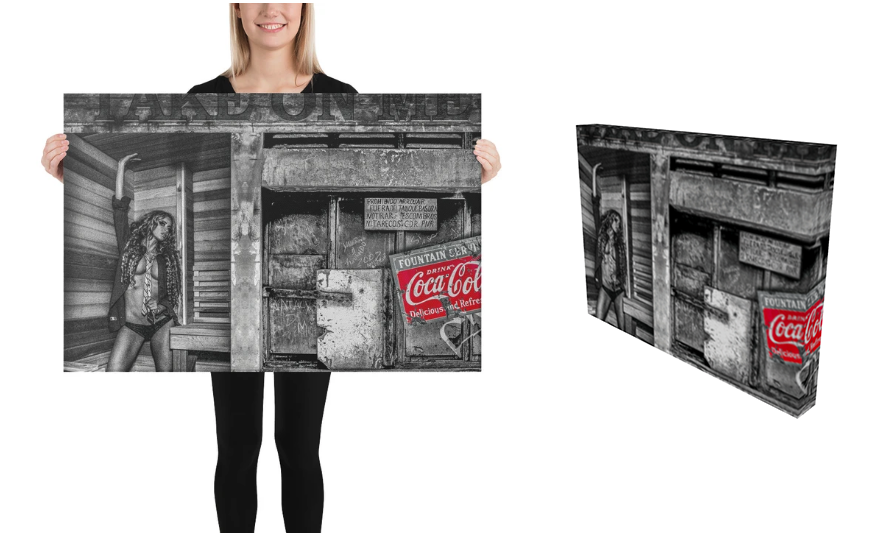
Girl on the Havana Ruins | Original Digital ART Canvas
This photo captures the beauty and decay of Havana’s historic buildings. The once-grand architecture now stands in ruins, with walls crumbling and facades faded. The passage of time and the effects of weather and neglect have taken their toll, but there is still a haunting elegance to these structures. The contrast between the ornate details of the past and the dilapidated present creates a striking visual composition. This photo is a poignant reminder of the city’s rich history and the urgent need for preservation efforts to save its architectural treasures.
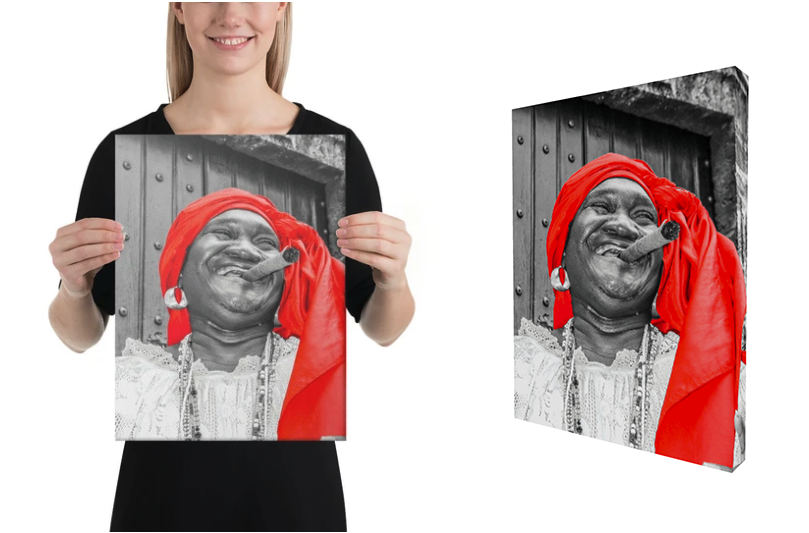
SANTERA CUBANA Original photography award | Canvas
Looking to add a little flair to your room or office? Look no further – this canvas print has a vivid, fade-resistant print that you’re bound to fall in love with.
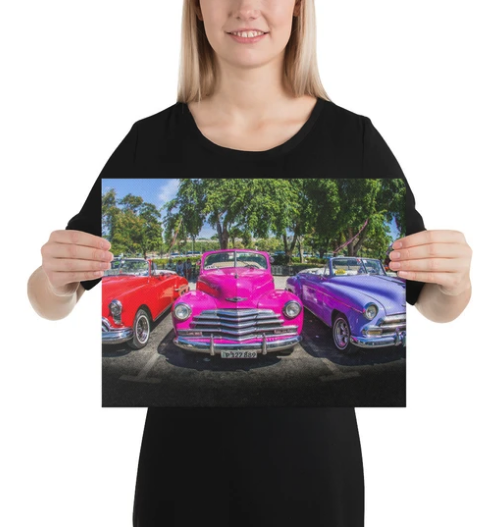
CLASSIC CARS HAVANA | COLOR Canvas
Looking to add a little flair to your room or office? Look no further – this canvas print has a vivid, fade-resistant print that you’re bound to fall in love with.
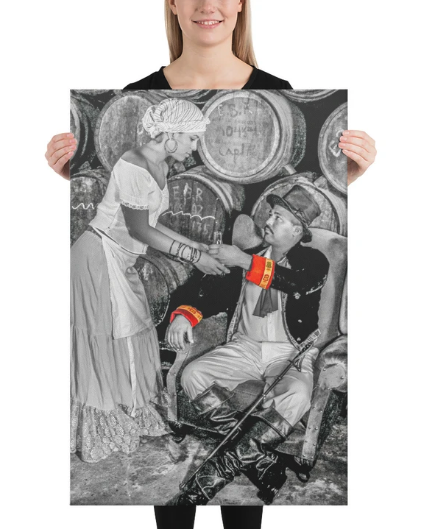
HAVANA Paticruzao | Canvas
According to legend, the name “Paticruzado” comes from a historical figure named Juan de la Cruz, who was a Spanish sailor and soldier stationed in Santiago de Cuba during the 16th century. He was known for his love of rum and was said to have created a special blend of rum that was highly prized by his fellow soldiers and sailors.
Over time, this blend of rum became known as “Ron Paticruzado” or “cross-legged rum,” as it was said that Juan de la Cruz would sit cross-legged while drinking it. Today, the name “Paticruzado” is associated with a number of different brands of rum produced in Cuba and elsewhere, although the exact recipe and production methods may vary.
Regardless of the brand, Cuban light rum is known for its smooth, mellow flavor and is a popular ingredient in many classic cocktails such as the mojito and daiquiri. It remains an important part of Cuba’s cultural heritage and is celebrated and enjoyed by people all over the world.
Classic Cars Canvas
Nothing is more representative of the Cuban capital than this fleet of classic vehicles that roam the streets like authentic rolling relics.
Start at the mythical Malecón breathing in the sea breeze, get lost in the old part until you find the Cathedral, cross Vedado with its ramshackle mansions and pass before the Capitol or the Plaza de la Revolución. There are only three conditions for this surprising route: activate laughter (and patience), roll down all the windows and raise the volume of the music to the rhythm, of course, of a son.
This is, broadly speaking, the experience of touring Havana aboard one of its mythical vintage automobiles, meticulously renovated in a waste of ingenuity. Vehicles that are inseparable from their anachronistic charm and that make up a most vintage image. Cadillacs, Buicks, Chevrolets, Ladas, Studebakers… And always in bright colors: bubblegum pink, pistachio green, orange, purple…
——————————————————
HAVANA CLASSIC COLOR CARS Canvas
Cars from the past that still roll in Havana to a Cuban survival model.
“Almendrones” is a term used in Cuba to refer to the classic American cars that are a common sight on the streets of Havana and other cities throughout the country. These cars date back to the 1950s and earlier, and their enduring popularity is a testament to the ingenuity and resourcefulness of the Cuban people.
Despite their age, “almendrones” are often meticulously maintained and beautifully restored, with shiny chrome detailing and brightly painted exteriors that harken back to a bygone era. Many of these cars have been modified with modern engines and other parts to keep them running smoothly, while still retaining their original charm and character.
For locals, “almendrones” are an essential part of daily life, serving as taxis, private vehicles, and even public transportation. For visitors to Cuba, these cars are a unique and memorable way to experience the country’s rich cultural heritage and history. Taking a ride in an “almendron” is a must-do experience for anyone visiting Cuba, and is sure to leave a lasting impression.
——————————————————
GO TO MENU. FOR MORE ART
NO + MUELA #patriayvida Short-Sleeve UNISEX T-Shirt
You’ve now found the staple t-shirt of your wardrobe. It’s made of 100% ring-spun cotton and is soft and comfy. The double stitching on the neckline and sleeves add more durability to what is sure to be a favorite!
• 100% ring-spun cotton
• Sport Grey is 90% ring-spun cotton, 10% polyester
• Dark Heather is 65% polyester, 35% cotton
• 4.5 oz/yd² (153 g/m²)
• Pre-shrunk
• Shoulder-to-shoulder taping
• Quarter-turned to avoid crease down the center
——————————————————
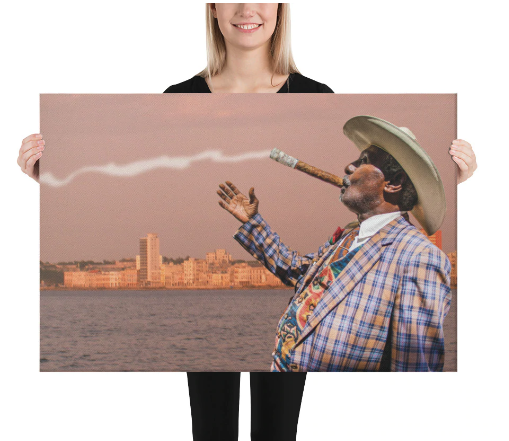
Cigar Life Benny More Digital Art | Canvas
——————————————————
Benny More impersonator.
Benny Moré was a legendary Cuban singer, bandleader, and composer, known as “El Barbaro del Ritmo” (The Master of Rhythm). He was born in the city of Santa Isabel de las Lajas, Cuba, on August 24, 1919, and rose to fame in the 1940s and 1950s, during the golden age of Cuban music.
Moré’s music was a fusion of Cuban rhythms such as son, bolero, and mambo, as well as jazz and other international styles. His powerful voice and charismatic stage presence made him a beloved figure in Cuba and throughout Latin America.
Some of Moré’s most famous songs include “Bonito y Sabroso,” “Que Bueno Baila Usted,” and “Cienfuegos.” He was also a talented composer, writing many of his own songs and collaborating with other musicians on new material.
Sadly, Moré died at the young age of 43, in 1963. However, his music continues to be celebrated and enjoyed by people all over the world, and he is widely regarded as one of the greatest and most influential musicians in the history of Cuban music.
Benny More impersonator wanders among tourists to collect some bucks. Looking to add a little flair to your room or office? Look no further – this canvas print has a vivid, fade-resistant print that you’re bound to fall in love with.
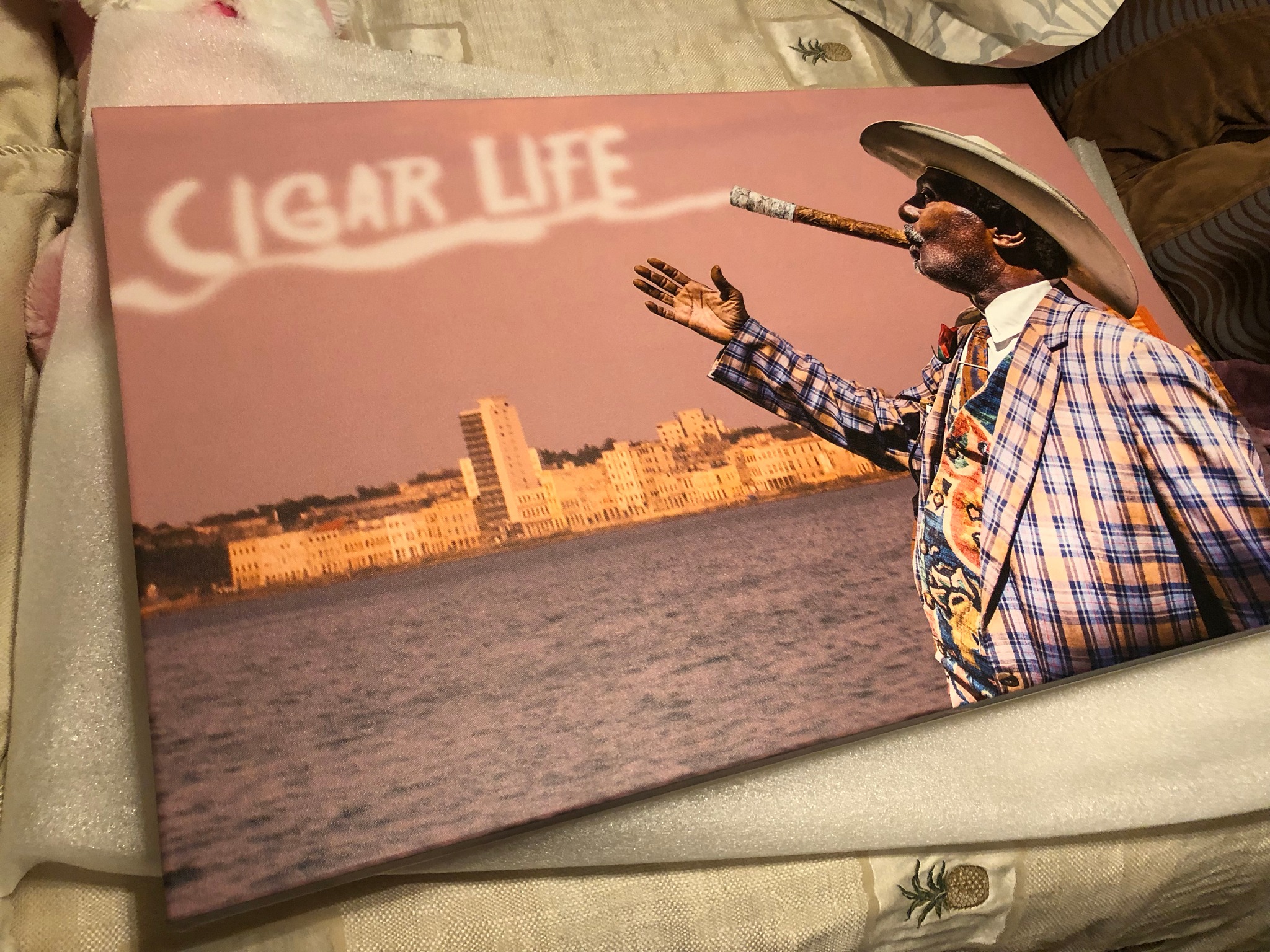
• Acid-free, PH-neutral, poly-cotton base
• 20.5 mils (0.5 mm) thick poly-cotton blend canvas
• Canvas Fabric weight: 13.9 oz/yd2(470 g/m²)
• Fade-resistant
• Hand-stretched over solid wood stretcher bars
• Matte finish coating
• 1.5″ (3.81 cm) deep
• Mounting brackets included
——————————————————
HAVANA Catedral Night | Color | Canvas
The thirty by forty-nine meters rectangular church serves as the seat of the Roman Catholic Archdiocese of San Cristobal de la Habana. The Catedral de la Habana, also known as the Cathedral of Havana, is a stunning example of Baroque architecture. The cathedral’s ornate façade features two bell towers and intricate stone carvings that are sure to catch the eye of anyone passing by. Inside, visitors are treated to a peaceful and serene atmosphere, with beautiful stained glass windows casting colorful light across the nave. The cathedral’s central altarpiece, featuring an image of the Virgin Mary, is a must-see for any art lover. Built between 1748 and 1777, this iconic cathedral has been a cornerstone of Havana’s spiritual and cultural heritage for centuries.
——————————————————

HAVANA CATEDRAL | Canvas
The Catedral de la Habana, also known as the Cathedral of Havana, is a stunning example of Baroque architecture. The cathedral’s ornate façade features two bell towers and intricate stone carvings that are sure to catch the eye of anyone passing by. Inside, visitors are treated to a peaceful and serene atmosphere, with beautiful stained glass windows casting colorful light across the nave. The cathedral’s central altarpiece, featuring an image of the Virgin Mary, is a must-see for any art lover. Built between 1748 and 1777, this iconic cathedral has been a cornerstone of Havana’s spiritual and cultural heritage for centuries.
CUBA PA’ LA CALLE | Short-Sleeve Unisex T-Shirt
You’ve now found the staple t-shirt of your wardrobe. It’s made of 100% ring-spun cotton and is soft and comfy. The double stitching on the neckline and sleeves add more durability to what is sure to be a favorite!
• 100% ring-spun cotton
• Sport Grey is 90% wingspan cotton, 10% polyester
• Dark Heather is 65% polyester, 35% cotton
• 4.5 oz/yd² (153 g/m²)
• Pre-shrunk
• Shoulder-to-shoulder taping
• Quarter-turned to avoid crease down the center
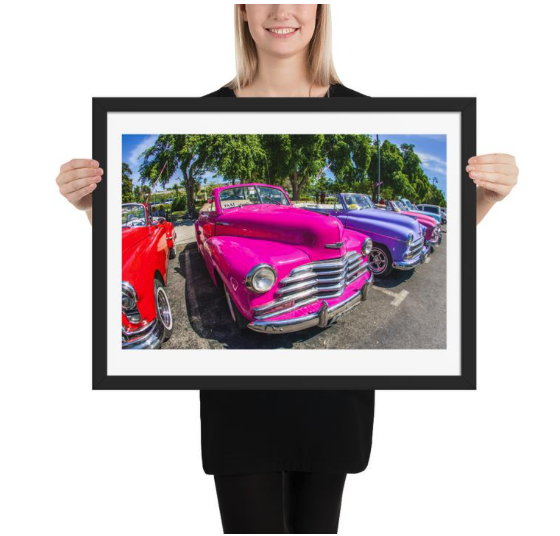
Classic Cars Cuba Photos | Framed poster
Today they look shiny and nickel-plated, but in reality, these cars date back to the 1950s, when Cuba was the largest importer of American automobiles. These jewels which, paradoxically, were the symbol of the American dream, have survived since the Revolution. Under the protection of a law that prohibited the entry of new vehicles, their owners had no choice but to sharpen their imaginations. Without access to spare parts, cars were patched with unlikely fixes, repaired over and over again, and resurrected inside and out.
Today, the almendrones, as Cubans call them, are among the great attractions travelers fervently photograph. And now that the unblocking and the new times have led to the takeoff of private businesses, the granting of licenses for their tourist exploitation has also become effective. The result is that these jewels have been miraculously revitalized.
Make a statement in any room with this framed poster, printed on thick, durable, matte paper. The matte black frame that’s made from wood from renewable forests adds an extra touch of class.
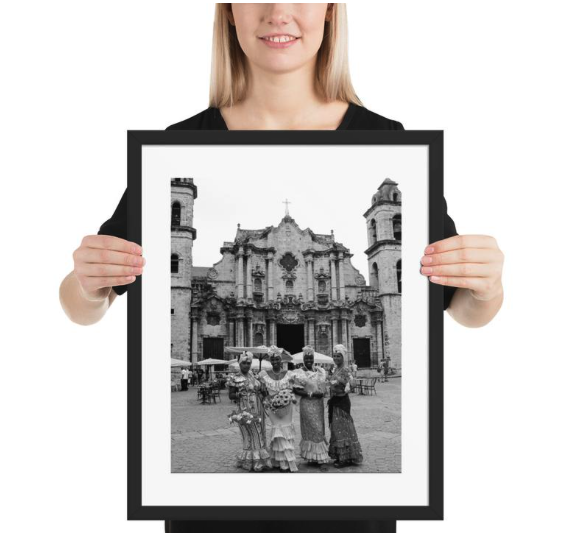
Mulatas en la Catedral de La Habana | Framed poster
Mulatas Cubanas are known for their striking beauty and unique cultural heritage. Their physical features typically combine African and European characteristics, resulting in a stunning blend of dark skin, curly hair, and striking facial features. In Cuban culture, Mulatas have long been celebrated for their strength, resilience, and sensual beauty, and have been the subject of many works of art and literature. Their contribution to the cultural richness of Cuba cannot be overstated, and they continue to be an important part of the country’s identity and heritage.
Mulata Cubana” is a Spanish term that refers to a woman of mixed African and European ancestry in Cuba.
Make a statement in any room with this framed poster, printed on thick, durable, matte paper. The matte black frame that’s made from wood from renewable forests adds an extra touch of class.
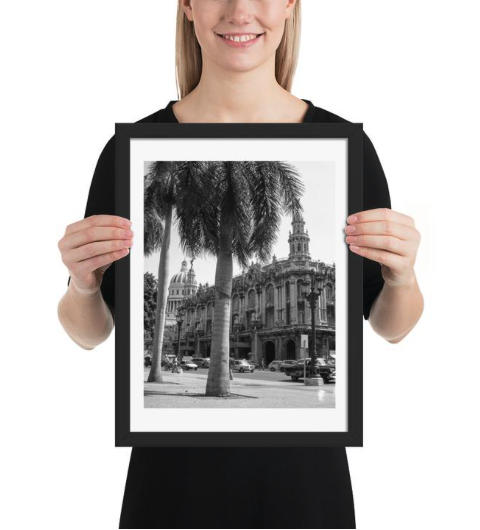
Central Park HAVANA original photography | Framed poster
Parque Central is a vibrant and bustling public park located in the heart of Havana, Cuba. Surrounded by stunning architectural landmarks such as the Gran Teatro de La Habana and the Hotel Inglaterra, the park serves as a popular gathering place for locals and tourists alike. From the towering statue of Jose Marti to the lush greenery and fountains, there is something for everyone in this lively and iconic space. Whether you are taking a stroll, enjoying a coffee at one of the outdoor cafes, or simply people-watching, Parque Central is a must-visit destination in Havana.
Make a statement in any room with this framed poster, printed on thick, durable, matte paper. The matte black frame that’s made from wood from renewable forests adds an extra touch of class.
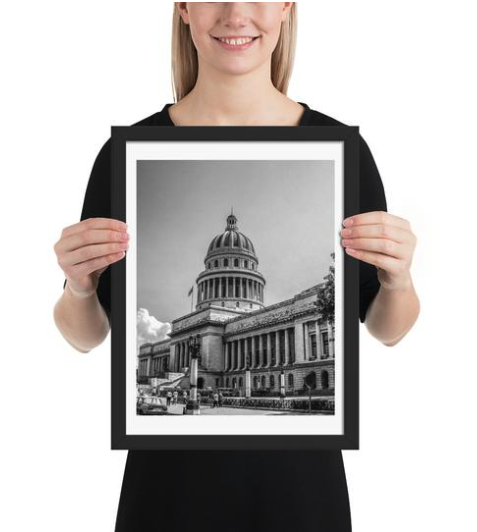
Capitol HAVANA original photography | Framed photo paper poster
Capitolio de la Habana
The Capitolio de la Habana, or the National Capitol Building of Havana, is an iconic landmark located in the heart of Havana, Cuba. Completed in 1929, the building was designed by the architects Raúl Otero and Eugenio Rayneri Piedra in the neoclassical style, and was modeled after the United States Capitol in Washington D.C.
The building’s most striking feature is its massive dome, which rises to a height of 92 meters (302 feet) and is visible from many parts of the city. Inside, the building houses the Cuban Academy of Sciences, as well as the National Library of Science and Technology.
The Capitolio was once home to the Cuban government, and many important historical events have taken place here, including the signing of the 1940 Cuban Constitution. Today, it serves as a popular tourist attraction, with visitors flocking to admire its grand architecture, stunning interiors, and historical significance.
In recent years, the building has undergone extensive renovations to restore it to its former glory. The project has included the restoration of the building’s exterior façade, the replacement of its original copper dome, and the refurbishment of many of its ornate interior features.

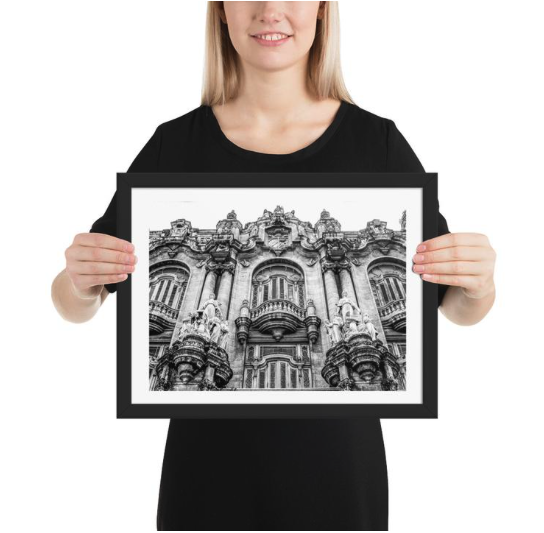
Great Theater of Havana Original photo | Framed poster
Gran Teatro de la Habana
The Gran Teatro de La Habana, located in the heart of Havana, is a breathtaking example of neoclassical architecture. Its ornate exterior boasts intricate details and elegant columns that create a sense of grandeur and sophistication. Inside, the theater’s opulent design features a stunning ceiling mural by Italian artist Giuseppe Perovani, as well as stunning marble staircases and a luxurious auditorium. It’s no wonder this iconic cultural institution has been a beloved landmark in Havana since it first opened in 1838.
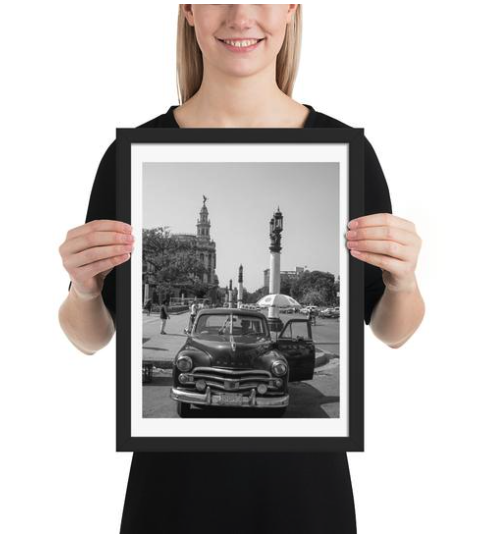
Classic Car Havana original photography | Framed photo paper poster
Faced with this reef, there are agencies that rent them with or without a driver to tour the island. At the airport itself or on the Paseo del Prado, in front of the Capitol, or at the García Lorca Theater, where the cars are displayed in a row in perfect magazine condition. And it is that nothing can be more fun than discovering the charms of Havana from the upholstered seats of these antique pieces, with which an authentic journey through time is guaranteed.
On the route, sensual and colorful, there will be no shortage of the great classics: Floridita and La Bodeguitade in the middle, the Hotel Nacional, the stalls in the Plaza de Armas, the Anti-Imperialist Tribune, paladares like La Guarida, the Coppelia ice cream parlor… But neither the new batch of hotels, cafeterias, shops and fashion venues that have been born in recent years, in the heat of an opening that has also meant that close to a third of the monumental heritage has been rehabilitated and that certain squares have been recovered.
Make a statement in any room with this framed poster printed on high-quality paper, with a partly glossy, partly matte finish.
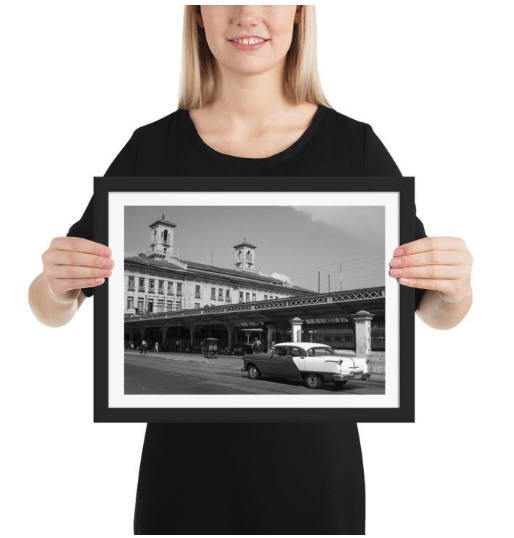
Havana Central railway station original photo | Framed poster
The Havana Central Railway Station, also known as Estación Central de Ferrocarriles, is an architectural masterpiece that has stood the test of time. Located in the heart of Havana, Cuba, the station was designed by the renowned New York-based firm of Warren and Wetmore, the same architects who designed the Grand Central Terminal in New York City. The station was inaugurated in 1912 and served as the main transportation hub for both passengers and cargo until the 1990s. Today, the station remains a historic landmark, with its ornate façade, grandiose columns, and intricate interior detailing still captivating visitors with its beauty and nostalgia. A true icon of Cuban history and architecture, the Havana Central Railway Station is a must-see for anyone interested in the rich cultural heritage of Cuba.
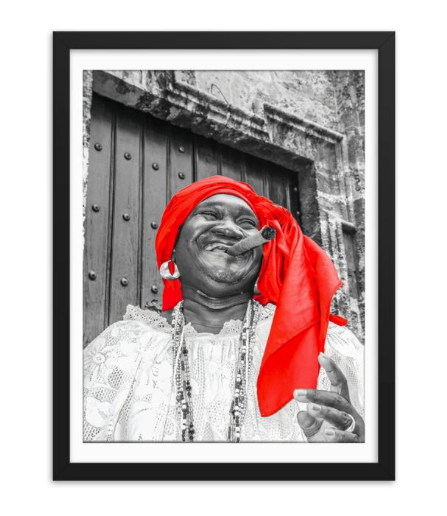
SANTERA CUBANA Original photography award | Framed poster
Juana la Cubana
Emblematic character of the cathedral square. the typical santera who reads letters
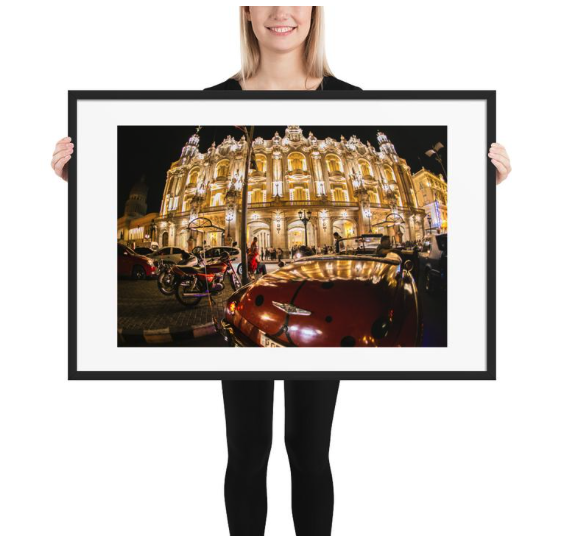
Great theater of Havana | Framed photo paper poster
Gran Teatro de La Habana is a theater in Havana, Cuba, home to the Cuban National Ballet. It was designed by the Belgian architect Paul Belau and built by Purdy and Henderson, Engineers in 1914 at the site of the former Teatro Tacón
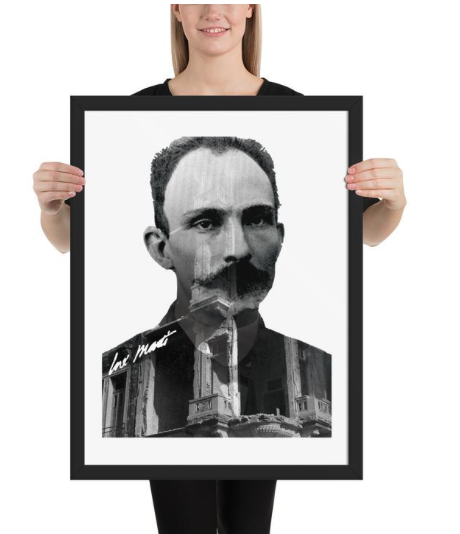
JOSE MARTI HAVANA RUINS ART | Framed photo paper poster
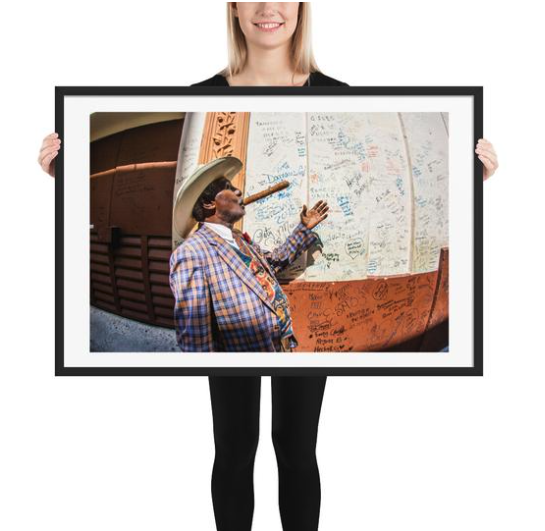
BENNY MORE HAVANA Award Photography | Framed Poster
Make a statement in any room with this framed poster, printed on thick, durable, matte paper. The matte black frame that’s made from wood from renewable forests adds an extra touch of class.

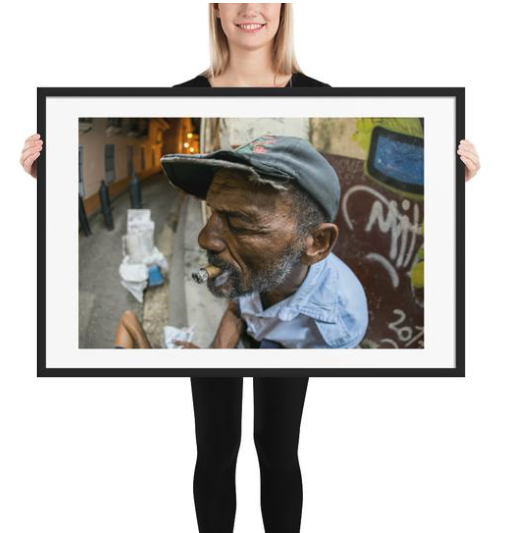
OLD Man Cigar Havana | Framed poster
The Cigar and the old man an old man enjoys the authentic Cigar in the hot nights of old Havana
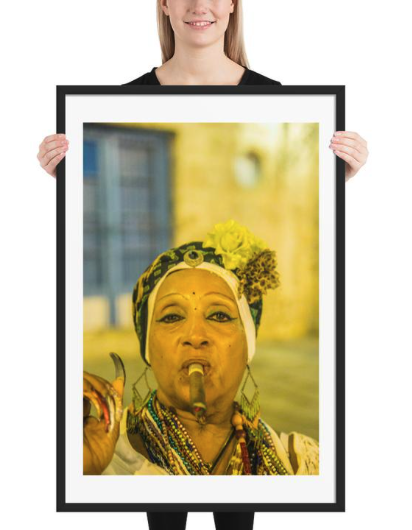
OLD Lady Cigar | Framed photo paper poster
Another character of the nights in Old Havana that has inspired photographers and film directors
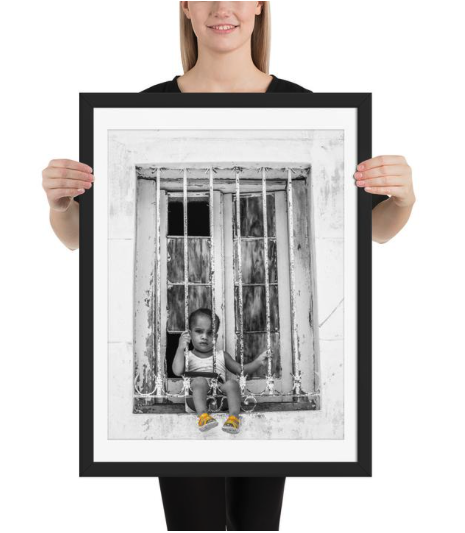
Havana Daycare original | Framed photo paper poster
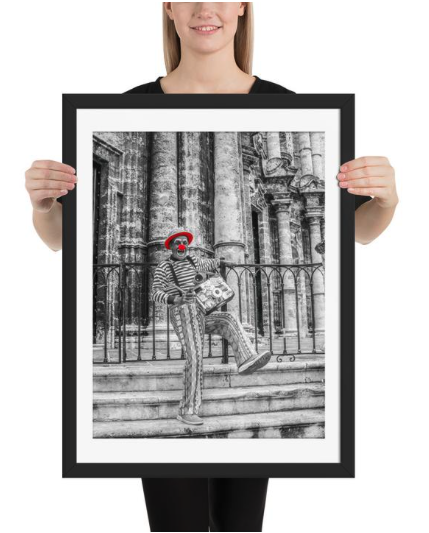
Havana Clown | Framed poster
Clowns on the old havana Artists try to earn a living in old Havana
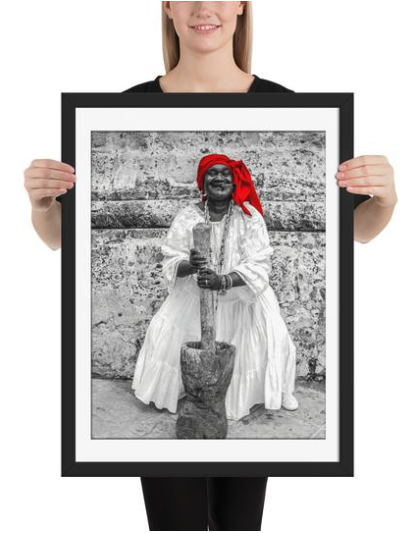
LA SANTERA Y EL PILON original | Framed photo paper poster
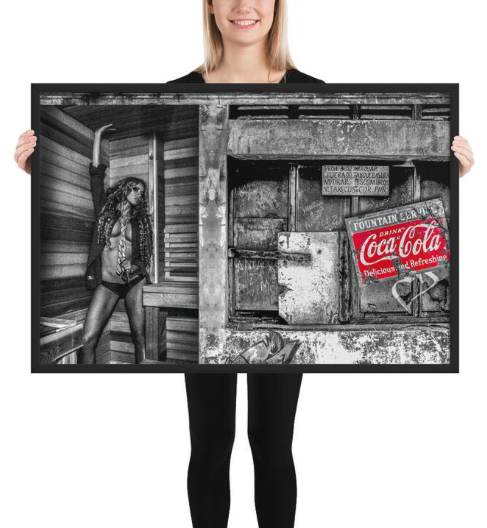
Girl on the Havana Ruins | Original Framed poster
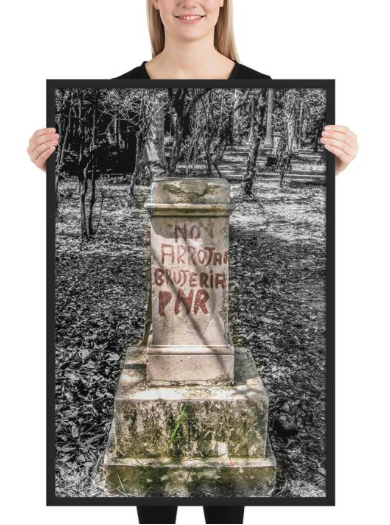
HAVANA PNR SIGNS Original photography Framed poster
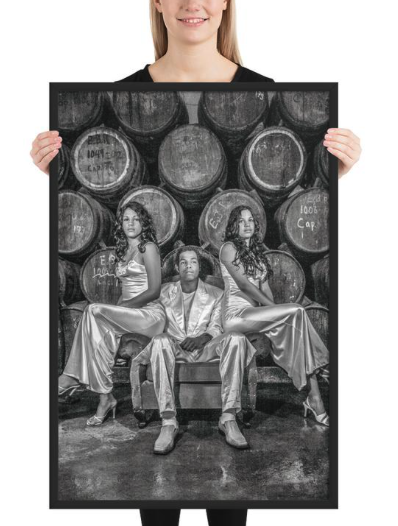
Rum and Mulatas original | Framed photo paper poster
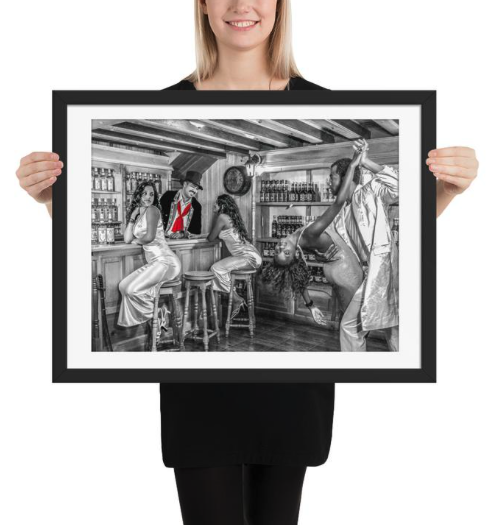
Havana Rum, Cigars and Dance | Framed poster
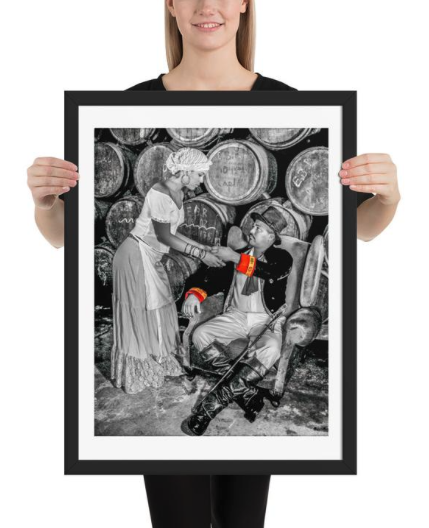
HAVANA Paticruzao | Framed photo paper poster
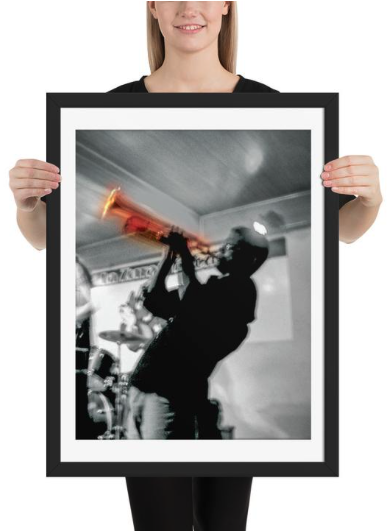
Havana Jazz | Framed poster
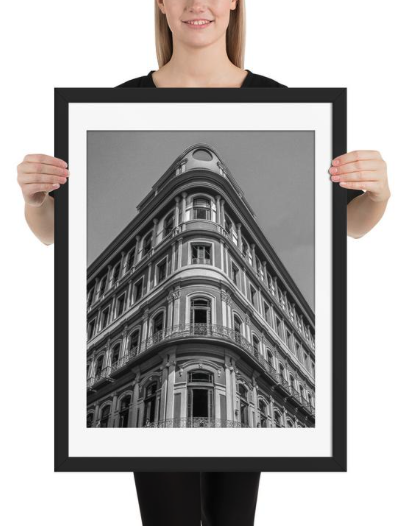
HAVANA Telegraph Hotel | ORIGINAL PHOTO Framed poster
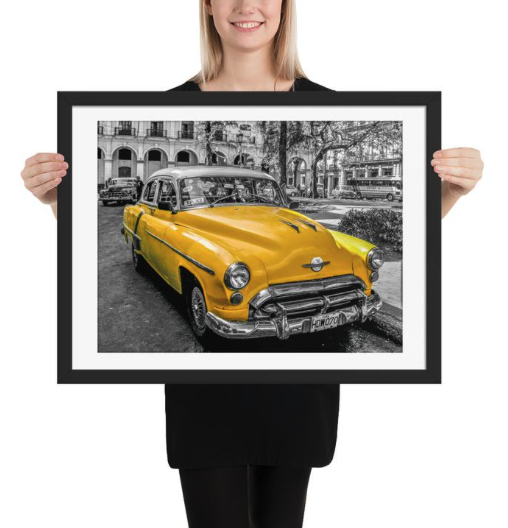
HAVANA CLASSIC CARS Original photography Framed poster
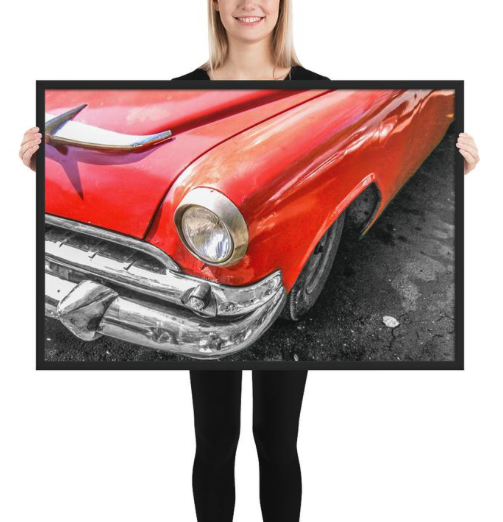
HAVANA CLASSIC RED CAR | Original photography Framed poster
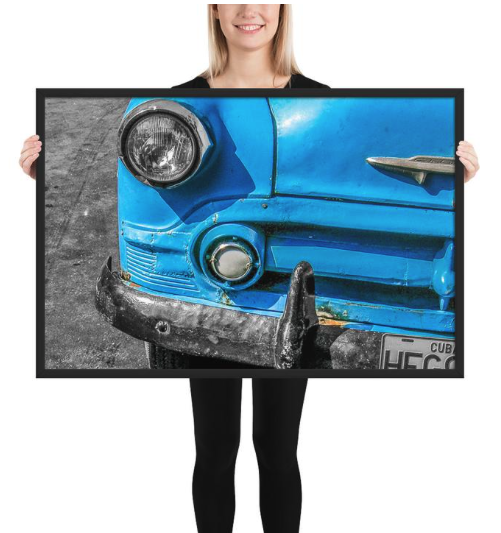
HAVANA CLASSIC BLUE CAR | Original photography Framed poster
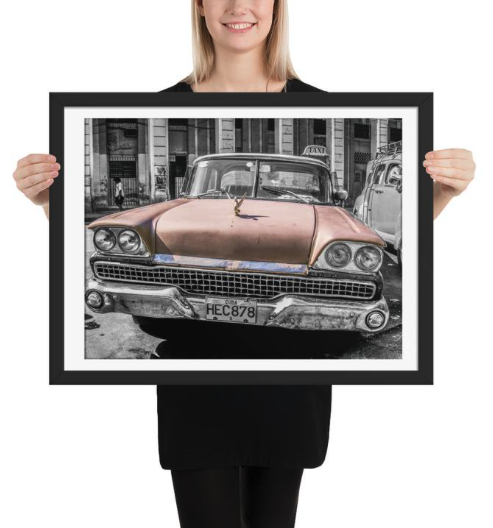
HAVANA CLASSIC CARS II Original photography Framed poster
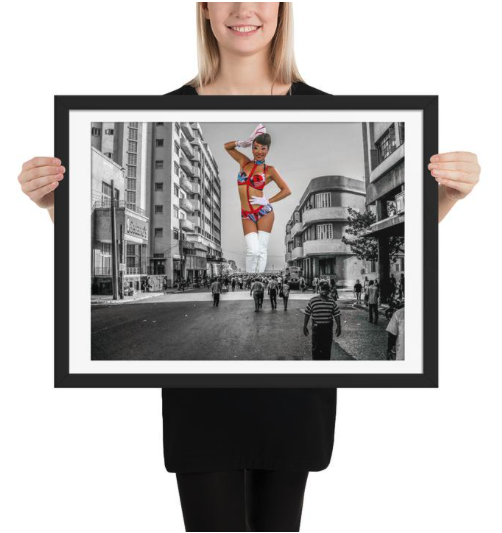
Digital ART Havana The March to Capitalism | Framed poster
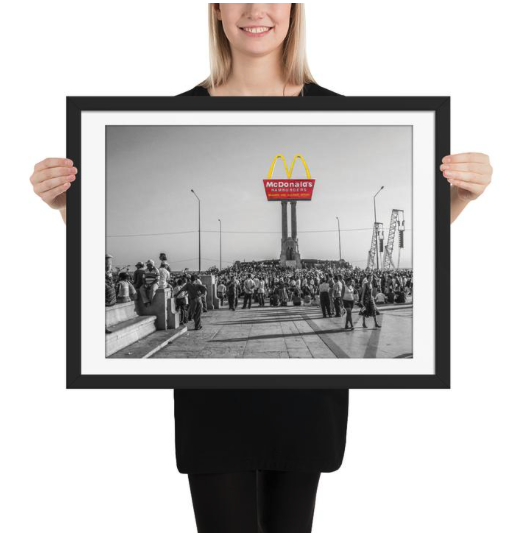
HAVANA MACDONALDS DREAMS Digital Art | Framed photo paper poster
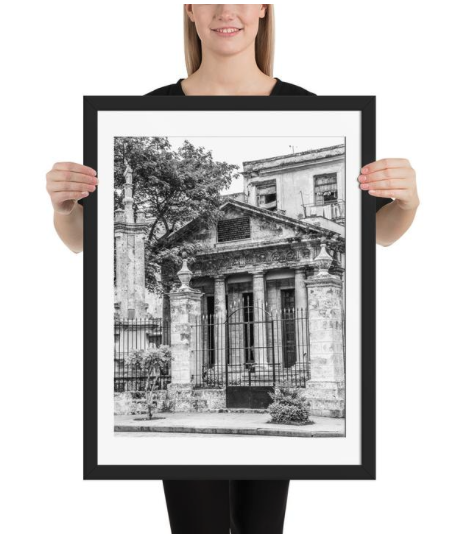
HAVANA Templete Original Photography | Framed poster
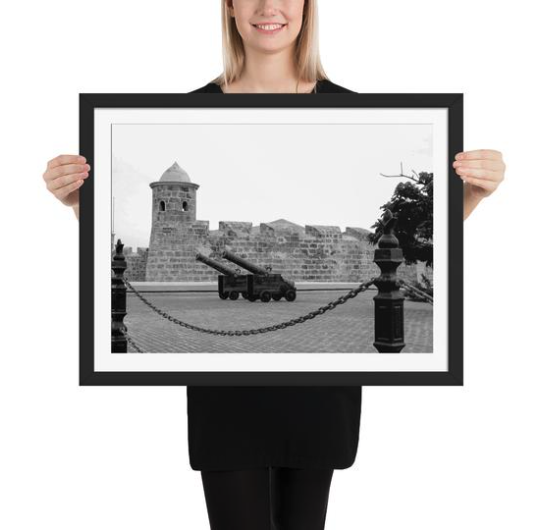
HAVANA (La Cabaña) ORIGINAL | Framed photo paper poster
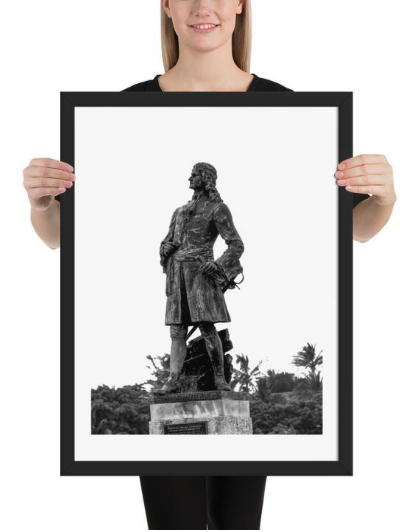
HAVANA Pierre Le Moyne D’Iberville ORIGINAL Photography Framed poster
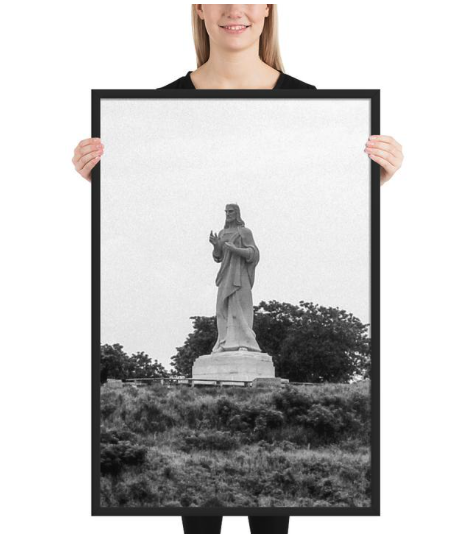
VINTAGE Christ of Havana | Framed ORIGINAL photo poster
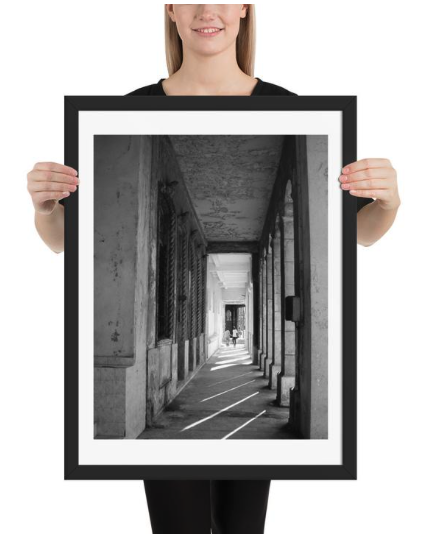
Old Havana Buildings | Framed poster
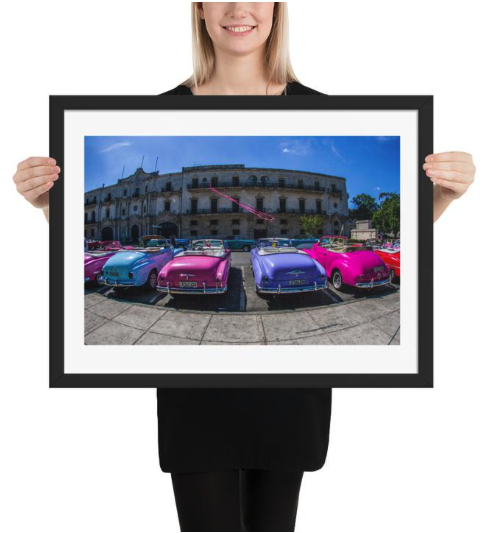
HAVANA CLASSIC COLOR CARS | Framed poster
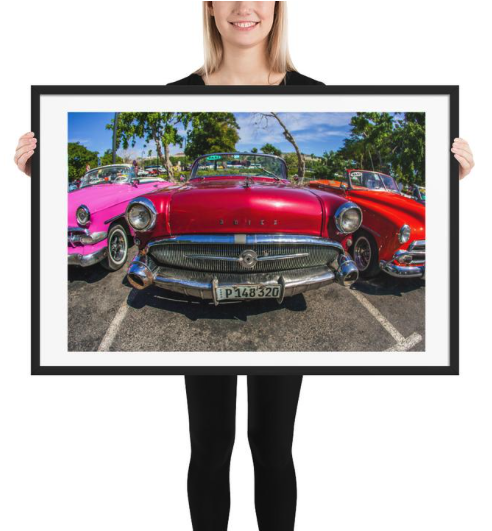
HAVANA CLASSIC RED CAR | Framed poster
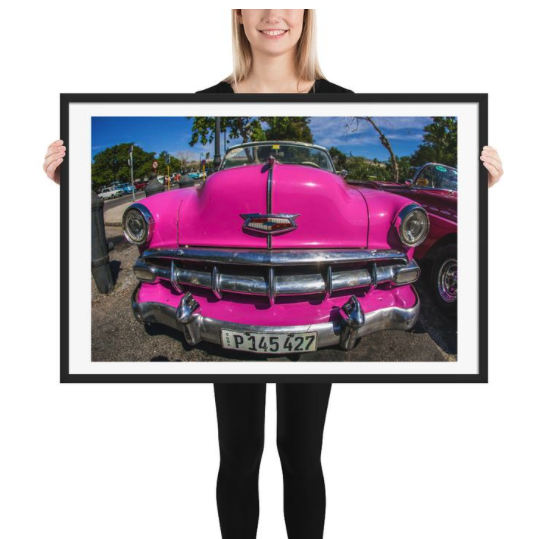
HAVANA CLASSIC PINK CAR | Framed poster
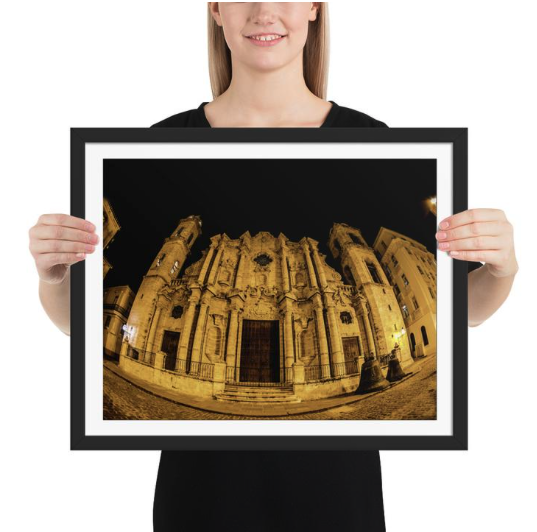
HAVANA Catedral Night | Framed poster
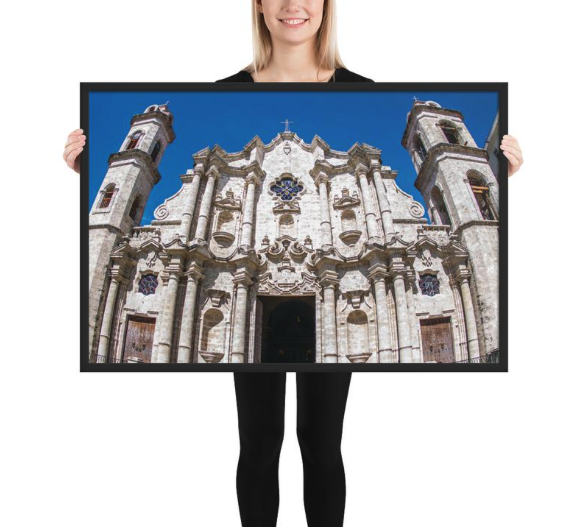
HAVANA CATEDRAL Color Framed poster
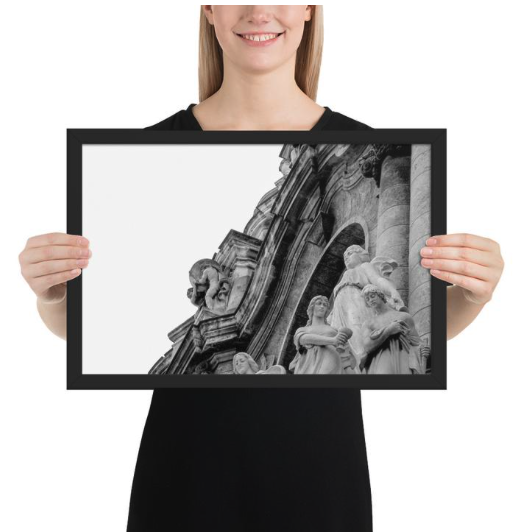
Great theater of Havana Vintage | Framed poster

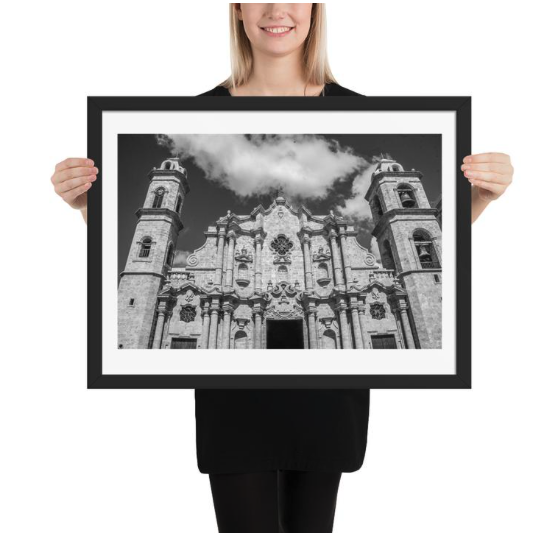
HAVANA CATEDRAL DAY | Framed poster
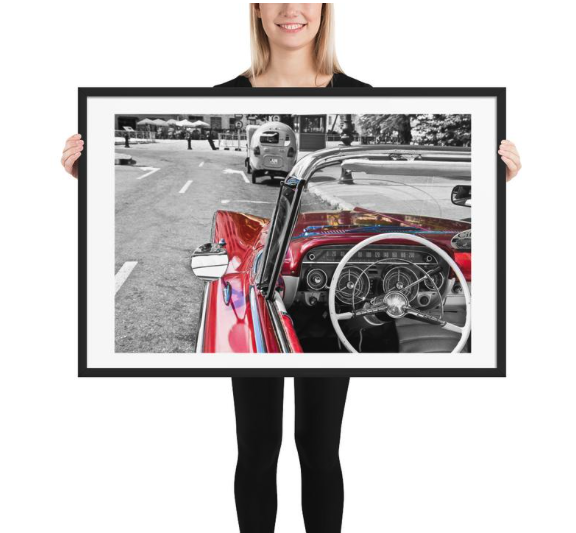
Havana Classics Cars interior | Framed poster
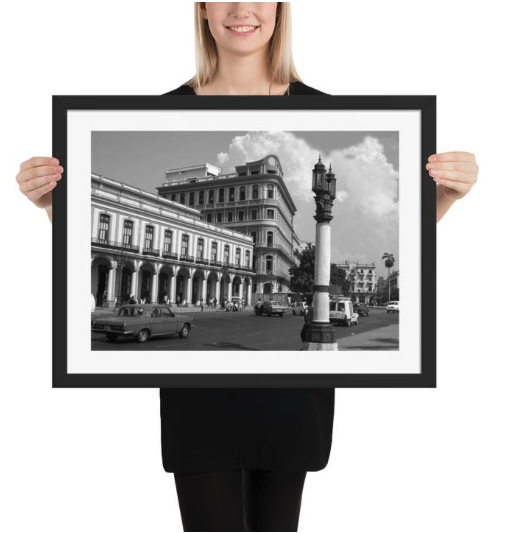
HAVANA Paseo del Prado | Framed poster

HAVANA DANCER | Framed matte paper poster
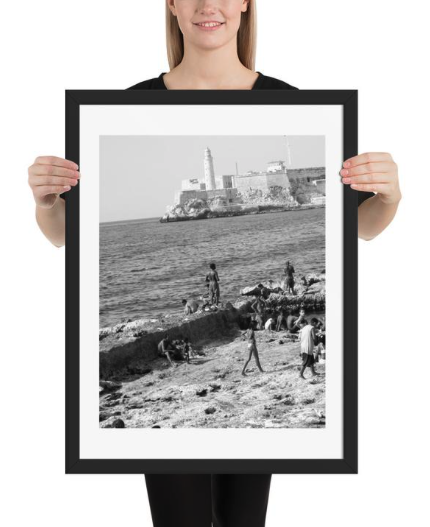
HAVANA SHORES MALECON Framed poster
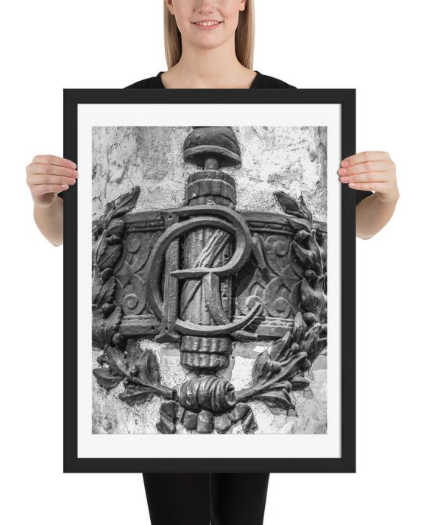
HAVANA Capitol Shield | VINTAGE Framed poster
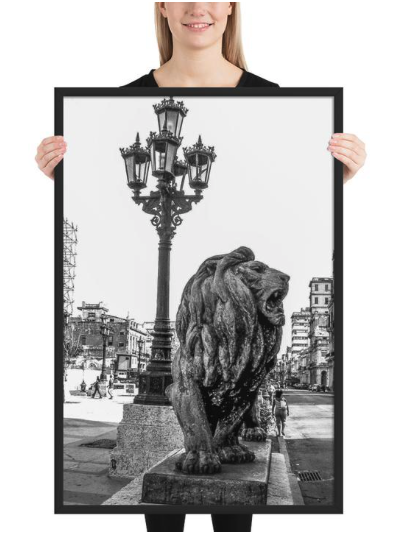
HAVANA VINTAGE Prado Street Lions | Framed poster
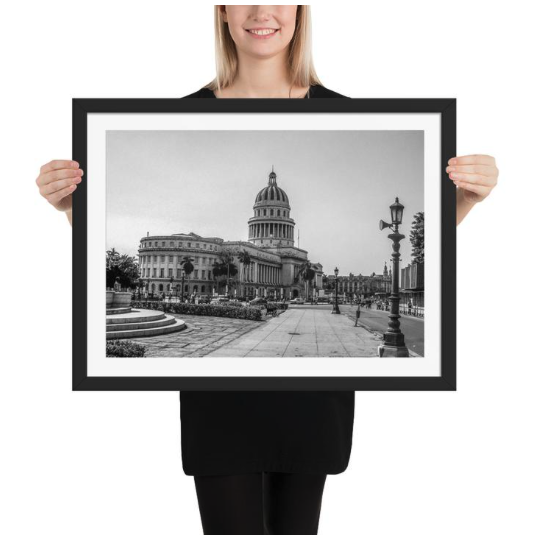
Capitol HAVANA II | Original photography | Framed poster
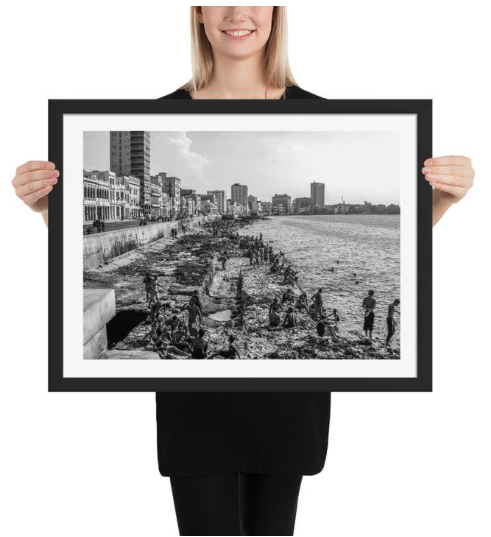
HAVANA Malecón people swimming Framed photo paper poster
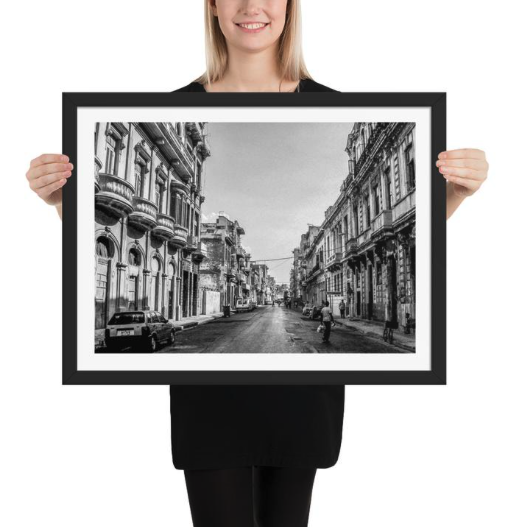
HAVANA San Lazaro Street | Framed photo paper poster
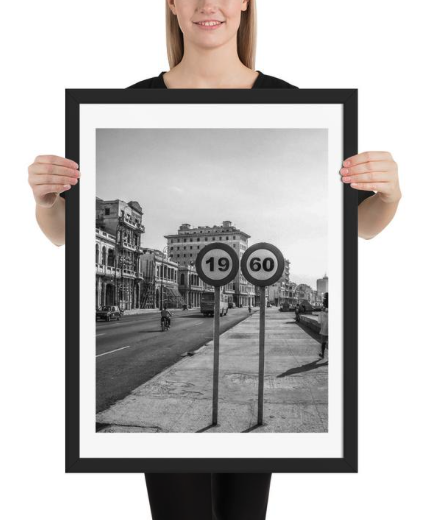
HAVANA 1960 Original Photo Framed poster
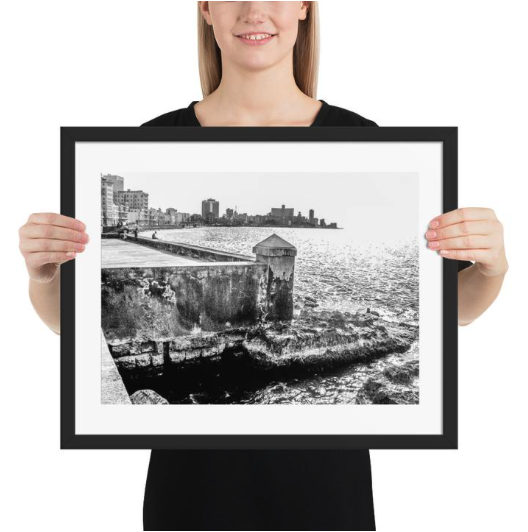
HAVANA Malecón | Framed photo paper poster
Make a statement in any room with this framed poster printed on high-quality paper, with a partly glossy, partly matte finish.
The Malecón (officially Avenida de Maceo) is a broad esplanade, roadway, and seawall that stretches for 8 km (5 miles) along the coast in Havana, Cuba from the mouth of Havana Harbor in Old Havana, along the north side of the Centro Habana neighborhood and the Vedado neighborhood, ending at the mouth of the Almendares River. New businesses are appearing on the esplanade due to economic reforms in Cuba that now allow Cubans to own private businesses.
GO TO MENU. FOR MORE ART
AWARDED PHOTOGRAPHY
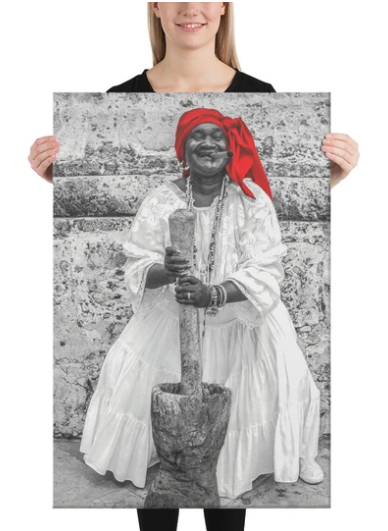
OLD HAVANA SANTERA & PILON | CANVAS
Juana y el pilon. The Pilón is an instrument to process the coffee bean and Juana is a famous card reader in Old Havana.
A “pilón” is a traditional wooden mortar and pestle used in Cuba to grind coffee beans. It is a common tool used in many Cuban households and is often considered an important part of Cuban culture.
To use a pilón, coffee beans are placed in the mortar and ground with a pestle until they are finely ground. This process can take some time and requires some effort, but many Cubans believe that the flavor of coffee ground in a pilón is superior to that ground in an electric grinder.
In addition to grinding coffee beans, a pilón can also be used to grind other ingredients such as spices, herbs, and grains. It is a versatile tool that has been used in Cuba for generations and is still popular today.
Looking to add a little flair to your room or office? Look no further – this canvas print has a vivid, fade-resistant print that you’re bound to fall in love with.
• Acid-free, PH-neutral, poly-cotton base
• 20.5 mils (0.5 mm) thick poly-cotton blend canvas
• Canvas Fabric weight: 13.9 oz/yd2(470 g/m²)
• Fade-resistant
• Hand-stretched over solid wood stretcher bars
• Matte finish coating
• 1.5″ (3.81 cm) deep
• Mounting brackets included
GO TO MENU. FOR MORE ART
———————————————————-
This collection has participated in different exhibitions and contests like the BBC photo contest 2002 | Havana Frozen in Time personal expo at Santo Domingo RD 2005 and University of Miami 2006 | Art takes New York Times Square 2011 | Scope Pavilion Art Basel 2012 and 2013.

SANTERA CUBANA Original photography award | Canvas
Looking to add a little flair to your room or office? Look no further – this canvas print has a vivid, fade-resistant print that you’re bound to fall in love with.
Santería is a syncretic religion that combines elements of West African Yoruba religion with Catholicism. It is widely practiced in Cuba and other parts of the Caribbean, as well as in Latin America and the United States.
In Santería, practitioners believe in a Supreme Being, Olodumare, and a pantheon of orishas or deities who represent different aspects of nature and human experience. These orishas are often associated with Catholic saints, and many Santería rituals and practices incorporate elements of Catholicism.
Santería rituals often involve the use of music, dance, and offerings such as food, candles, and flowers. These offerings are meant to honor the orishas and seek their blessings and protection. Santería practitioners also often use divination to communicate with the orishas and seek guidance.
Despite facing persecution and discrimination throughout its history, Santería has remained an important part of Cuban culture and identity. It has also significantly impacted the development of other Afro-Caribbean religions, such as Vodou and Candomblé.
———————————————————-

HAVANA Capitol II Canvas
The Capitolio de la Habana, or the National Capitol Building of Havana, is an iconic landmark located in the heart of Havana, Cuba. Completed in 1929, the building was designed by the architects Raúl Otero and Eugenio Rayneri Piedra in the neoclassical style and was modeled after the United States Capitol in Washington D.C.
The building’s most striking feature is its massive dome, which rises to a height of 92 meters (302 feet) and is visible from many parts of the city. Inside, the building houses the Cuban Academy of Sciences, as well as the National Library of Science and Technology.
The Capitolio was once home to the Cuban government, and many important historical events have taken place here, including the signing of the 1940 Cuban Constitution. Today, it serves as a popular tourist attraction, with visitors flocking to admire its grand architecture, stunning interiors, and historical significance.
In recent years, the building has undergone extensive renovations to restore it to its former glory. The project has included the restoration of the building’s exterior façade, the replacement of its original copper dome, and the refurbishment of many of its ornate interior features.
———————————————————-
HAVANA VINTAGE Prado Street Lions | Canvas
Looking to add a little flair to your room or office? Look no further – this canvas print has a vivid, fade-resistant print that you’re bound to fall in love with.
VINTAGE Prado Street Lions. The photographs were taken with an SLR camera and have a textured grain style.
———————————————————-

HAVANA Door knockers Canvas
The “Aldaba de las puertas” or “door knocker” of the Cathedral of Havana is a unique and ornate feature that has become an iconic symbol of the cathedral. Made of solid bronze, the knocker is designed in the shape of a lion’s head, with intricate details that highlight its strength and ferocity.
The lion’s head is flanked by two smaller heads that are believed to represent indigenous people of the Americas, symbolizing the blending of cultures that have defined Cuban history. The door knocker is also decorated with floral and geometric motifs, which add to its overall beauty and complexity.
As a functional piece of architectural detail, the door knocker is used to alert those inside the cathedral of the arrival of visitors. When the knocker is lifted and released, it produces a loud banging sound that echoes through the halls of the cathedral.
Overall, the “Aldaba de las puertas” is an impressive example of the exquisite craftsmanship and attention to detail that is characteristic of Cuban art and architecture. It is a must-see for anyone visiting the Cathedral of Havana and is sure to leave a lasting impression.
———————————————————-

Girl on the Havana Ruins | Original Digital ART Canvas
This photo captures the beauty and decay of Havana’s historic buildings. The once-grand architecture now stands in ruins, with walls crumbling and facades faded. The passage of time and the effects of weather and neglect have taken their toll, but there is still a haunting elegance to these structures. The contrast between the ornate details of the past and the dilapidated present creates a striking visual composition. This photo is a poignant reminder of the city’s rich history and the urgent need for preservation efforts to save its architectural treasures.
CLICK HERE TO SEE THE ENTIRE PHOTO EXPO
GO TO MENU. FOR MORE ART
Buy Safe with Funtrending on the website online store on find us on Ebay.
